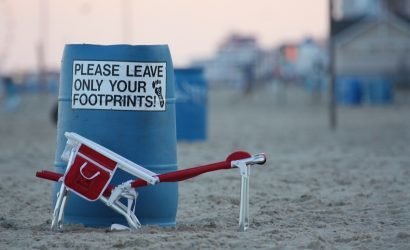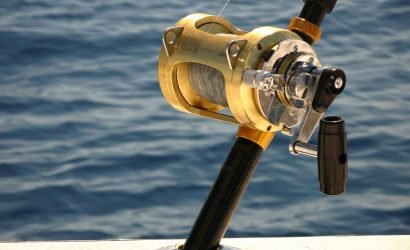It was 50 years ago; the wind was whipping, the seas were high, houses and businesses washed away, debris flooded Coastal Highway (then called Beach HIghway) —and the ocean met the bay. At 5:30 p.m. on March 7, the exact time when the Storm of 1962 reached it’s peak half a century ago, leaving the entire town under water, hundreds will gather at the Roland E. Powell Convention Center in Ocean City, MD for a commemorative event.
The Museum Society’s “Storm Party,” a collaborative effort from the Lifesaving Station Museum’s Board of Directors, seeks to raise funds, quite aptly, for storm shutters for the museum. Guests will be treated to a cocktail reception at 5:30, dinner at 6:30, and a viewing of the new documentary film produced by Terry Sterner featuring the firsthand accounts of 25 storm “survivors.” It will be a night full of reminiscing and celebration in honor of an historical event —anyone who lived in, or visited Ocean City at the time is encouraged to attend. Tickets are $50 a piece and can be purchased in advance, here. Tickets will not be sold at the door.
The Worst Storm in History
.JPG) |
Apartments on 19th Street, Ocean City, MD. Photo courtesy of J.D Quillin from the collection of the Ocean City Life-Saving Museum. |
During March 6-8th, 1962, Ocean City, MD and the entire Delmarva and mid-Atlantic coasts experienced a storm that was considered worse than the 1933 hurricane that cut the inlet, creating the Commercial Fishing Harbor and paving the way for Ocean City to become the White Marlin Capitol of the World. What happened in 1962 wasn’t a hurricane, it was a strong nor’easter, and as many locals would say, those can pound the coast worse than the storms that sometimes threaten during hurricane season.
The conditions during the 1962 Storm were near perfect for disaster. The storm had stalled off the coast for nearly three days, and when coupled with a new moon, resulted in seas that were 9 feet 4 or 5 inches above the mean low tide, a full two feet over the measured tides in the 1933 hurricane, according to an article published in the Salisbury Times during the storm.
That same article stated, “there were reports that another inlet had been cut, and that fires have gone unchecked on the northern portion of the island,” which indeed turned out to be true—the new inlet was on 71st street.
It was worse than anyone had anticipated. When the storm finally moved on, it had caused over 20 million dollars in damage.
A Small Town Comes Together
 |
Bunk Mann, author of Vanishing Ocean City |
Bunk Mann, local insurance broker by trade, impassioned local historian, and a member of the museum board was just 15-years-old at the time of the storm. He also happened to play guitar in a rock and roll band. The town of Ocean City was under Marshall Law for a few days following the storm, and the National Guard had moved in. Mann’s band was hired by Junior Evans to play at his business on 18th street–Junior’s Drive-In, as entertainment for the National Guard. Mann recalls,
“I think what I remember most were the piles of sand out in the street, piles of sand everywhere. Philadelphia Avenue, Baltimore Avenue, were just sand dunes and junk—everything from refrigerators to pieces of boardwalk. It just looked apocalyptic.”
Mann is currently in the midst of writing a book on the history of Ocean City entitled, Vanishing Ocean City. Mann plans for the book to be filled with pictures he’s amassed, and stories from locals whose combined efforts have made Ocean City into the town it is today. Through all of his research, and personal experience living in and around Ocean City, Mann is able to paint a vivid picture of what the town was like when the 1962 storm hit—very different from the burgeoning metropolis and year-round resort it is today.
“The last real hotel on the Boardwalk was the Harrison Hall on 15th Street. Motel row on 15th to 33rd, was in its infancy. The Harrington Arms was there, the Santa Maria, and the Seascape, the Surf and Sands, the Sandy Hill and the Flamingo had just been built and there was lots of open space. There was really nothing past 33rd, except cottages, a few small motels, the Castle in the Sand, and the Carousel, which was in the process of being built that year.”
The level of development in Ocean City was undoubtedly small in comparison with today. Many of those who have studied Ocean City, including Mann and well-known historian George Hurley credit the 1962 Storm with the building boom that would follow. The storm caused property values to decrease, which attracted investors. As a result, the town was annexed from 45th street to the Delaware line, and water and sewer lines were extended, opening the gateway for development.
But prior to the aftermath, Ocean City was really just a small town, run by a few families who worked tirelessly from Memorial Day to Labor Day, when the tourists came “down the ocean.”
Says Mann, “The day after Labor Day you could stand on the Boardwalk and there would be no one. It was really just the locals here when the storm hit in March.”
 |
Ocean Mist, 47th Street, Ocean City, MD. Photo courtesy of Charlotte Parker from the collection of Bunk Mann. |
In conducting his interviews with eyewitnesses, Mann got the feeling that people were pretty calm about the storm, and he didn’t hear any tales of looting. But then again, most people in Ocean City were related, or at the very lest, knew one another.
This was a town full of hardworking people; their reliance on one another evident in passages taken from, The Tides of March, written by Beryl and Bill Dryden directly following the storm, (a complimentary reprinted copy will be given to each person who purchases two tickets to the Storm Party.) In a passage entitled, “Hams What I Am!,” the “hobby” of at least a dozen Ocean City and Berlin area men—known as hams—play a vital role in rescuing residents.
The Citizen’s Band Radios were used to communicate once the phone lines went out, and also because those who owned the radios had created their own network useful to the rescue. Bill Bunting, who sat on his radio from Tuesday evening March 6th, through Thursday morning March 8th, estimated that he received 200 rescue calls. Bunting also took in calls from the fire department—and coordinated the effort with other hams, who would then dispatch any type of floatable or large vehicle—from dump trunks to out board boats, to rescue those trapped.
Other first-hand accounts of the storm can be read as part of the Ocean City Life Saving Station Museum Collection. Many more will be included in Sterner’s video, that will be showcased at the Storm Party.
A Personal Account – Surviving Danger and Seeing Tragedy
 |
Car underwater at 71st Street temporary inlet. Storm-related death occurred here. Photo by Robe Holland, courtesy of Mary Belle Holland, from the collection of Bunk Man. |
In conducting his book research, one account of the storm stood out for Mann. This particular eyewitness story conjures up swells of emotion, and illustrates the very real danger locals faced so close to nature’s wrath.
Barbara Entwistle and her mother, Kitty Hearne, were babysitting two children, an infant and a four-year-old boy named Benny, in their home in the Little Salisbury neighborhood of Ocean City, (the neighborhood was the first of its kind in the area, a development on the bayside, and quite isolated at the time.) They became trapped in their home, and the amphibious Coast Guard Duck had to rescue them. What followed, as told from Entwhistle and Hearne, to Mann, is paraphrased here.
Mann recalls from his interview, “They had to travel over the inlet [the new one, cut at 71st st., possible only because they were in the amphibious Duck.] Barbara knew the boy would see his father’s car where it had gotten stuck when the inlet was cut. She used her coat to shield his eyes.”
The children’s father, Jimmy Wilson, a Trailways bus driver, died after exiting his vehicle trying to escape, and was one of two fatalities that occurred in Ocean City as a result of the storm. The other happened when a fishing boat overturned off the coast of Assateague Island.
A Positive Outcome
 |
Ember’s Restaurant damage on 9th Street, Ocean City, MD. Photo courtesy of Charlotte Parker from the collection of Bunk Mann. |
Despite the devastation—in addition to the damage incurred by homes and businesses, the entire boardwalk was destroyed and tons of sand and debris filled the streets—the town was fully operational and open for business Memorial Day Weekend, a mere two months and change after the worst storm in the town’s history. For Mann, this coming together of the town in recovery is a pivotal part of the storm’s story. He credits the locals, the Ocean City Mayor at the time, Hugh Cropper, and J Millard Tawes, then Maryland Governor and Crisfield native, for getting the job done.
Even when storms bring destruction, they can also bring positive change. As was the case with the 1933 storm, and the inlet it created, and so was the case with the building boom into North Ocean City that occurred after the 1962 storm. Mann brings to light another change that resulted from both storms,
'“If it hadn’t been for the 33 storm, and again later the one in 62, Assateague Island would look just like Ocean City.”
Today, Assateague Island is a beautifully wild place full of horses, animals, and natural beauty, as opposed to the hotels, motels, and condos. It’s planned development altered by Mother Nature. For anyone living close to the coast, there is a very real understanding that the landscape is ever changing. Sometimes it takes centuries, other times just a few days, when the power of the sea turns its energies to the shores. Those who recall the Storm of 1962 witnessed this mighty force, firsthand.
Additional Information:
- The Storm Party is Wednesday, March 7th at 5:30 p.m.
- Tickets are $50 each, and can be purchased by visiting the Ocean City Lifesaving Station’s Website.
- Please note, tickets will not be sold at the door, and must be purchased in advance.









